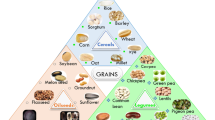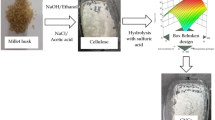Abstract
Drying is one of the most cost-effective methods of worthwhile by-product valorisation. This study had two main objectives. The first was to determine the effect of hot air drying (HAD) combined with microwave (MW) irradiation on the treatment kinetics and the macrostructural and microstructural properties of the dried product. The second aim was to develop engineering tools to predict the extent of dehydration. Drying was performed using hot air at 55 °C and the combined (HAD + MW) treatment at different power intensities (2, 4, and 6 W/g). After 5, 15, 40, 60, and 120 min, the mass, surface, volume, water activity and moisture were measured in fresh and dried samples. Sorption isotherms were obtained and fitted to the GAB model, with high correlation coefficients. The macroscopic and microscopic analyses showed shrinkage and swelling in the peel tissue caused by the MW treatment. The HAD + MW methods not only resulted in increased moisture reduction but also induced microstructural changes that generated higher sorption capacity.











Similar content being viewed by others
References
Al-Muhtaseb, A. H., McMinn, W. A. M., & Magee, T. R. A. (2002). Moisture sorption isotherm characteristics of food products: a review. Food and Bioproducts Processing, 80(2), 118–128. https://doi.org/10.1205/09603080252938753.
Andrade, R. D., Lemus, R., & Pérez, C. E. (2011). Models of sorption isotherms for food: uses and limitations. Vitae, 18(3), 325–334.
Bejar, A. K., Ghanem, N., Mihoubi, D., Kechaou, N., & Mihoubi, N. B. (2011). Effect of infrared drying on drying kinetics, color, total phenols and water and oil holding capacities of orange (Citrus sinensis) peel and leaves. International Journal of Food Engineering, 7(5). https://doi.org/10.2202/1556-3758.2222.
Bergese, P. (2006). Specific heat, polarization and heat conduction in microwave heating systems: a nonequilibrium thermodynamic point of view. Acta Materialia, 54(7), 1843–1849. https://doi.org/10.1016/j.actamat.2005.11.042.
Castro-Giráldez, M., Fito, P. J., Chenoll, C., & Fito, P. (2010). Development of a dielectric spectroscopy technique for the determination of apple (Granny Smith) maturity. Innovative Food Science & Emerging Technologies, 11(4), 749–754. https://doi.org/10.1016/j.ifset.2010.08.002.
Castro-Giráldez, M., Fito, P. J., Dalla Rosa, M., & Fito, P. (2011a). Application of microwaves dielectric spectroscopy for controlling osmotic dehydration of kiwifruit (Actinidia deliciosa cv Hayward). Innovative Food Science & Emerging Technologies, 12(4), 623–627. https://doi.org/10.1016/j.ifset.2011.06.013.
Castro-Giráldez, M., Fito, P. J., & Fito, P. (2011b). Application of microwaves dielectric spectroscopy for controlling long time osmotic dehydration of parenchymatic apple tissue. Journal of Food Engineering, 104(2), 227–233. https://doi.org/10.1016/j.jfoodeng.2010.10.034.
Demirel, Y., & Sandler, S. I. (2001). Linear-nonequilibrium thermodynamics theory for coupled heat and mass transport. International Journal of Heat and Mass Transfer, 44(13), 2439–2451. https://doi.org/10.1016/S0017-9310(00)00291-X.
Edrisi Sormoli, M., & Langrish, T. A. G. (2015). Moisture sorption isotherms and net isosteric heat of sorption for spray-dried pure orange juice powder. LWT—Food Science and Technology, 62(1, part 2), 875–882. https://doi.org/10.1016/j.lwt.2014.09.064.
Fava, F., Zanaroli, G., Vannini, L., Guerzoni, E., Bordoni, A., Viaggi, D., Robertson, J., Waldron, K., Bald, C., Esturo, A., Talens, C., Tueros, I., Cebrián, M., Sebők, A., Kuti, T., Broeze, J., Macias, M., & Brendle, H. G. (2013). New advances in the integrated management of food processing by-products in Europe: sustainable exploitation of fruit and cereal processing by-products with the production of new food products (NAMASTE EU). New Biotechnology, 30(6), 647–655. https://doi.org/10.1016/j.nbt.2013.05.001.
Fernández-López, J., Sendra-Nadal, E., Navarro, C., Sayas, E., Viuda-Martos, M., & Alvarez, J. A. P. (2009). Storage stability of a high dietary fibre powder from orange by-products. International Journal of Food Science and Technology, 44(4), 748–756. https://doi.org/10.1111/j.1365-2621.2008.01892.x.
Ghanem, N., Mihoubi, D., Kechaou, N., & Mihoubi, N. B. (2012). Microwave dehydration of three citrus peel cultivars: effect on water and oil retention capacities, color, shrinkage and total phenols content. Industrial Crops and Products, 40, 167–177. https://doi.org/10.1016/j.indcrop.2012.03.009.
Gómez, A., López, R., Esturo, A., Bald, C., Tueros, I., Talens, C., & Raynaud, C. (2015). From waste products to raw materials for the development of new foods. Proceedings of the Institution of Civil Engineers: Waste and Resource Management, 168(2), 55–62. https://doi.org/10.1680/warm.13.00038.
Hossain, M. D., Bala, B. K., Hossain, M. A., & Mondol, M. R. A. (2001). Sorption isotherms and heat of sorption of pineapple. Journal of Food Engineering, 48(2), 103–107. https://doi.org/10.1016/s0260-8774(00)00132-1.
Igual, M., Contreras, C., & Martinez-Navarrete, N. (2010). Non-conventional techniques to obtain grapefruit jam. Innovative Food Science & Emerging Technologies, 11(2), 335–341. https://doi.org/10.1016/j.ifset.2010.01.009.
Kowalski, S. J., Rajewska, K., & Rybicki, A. (2005). Stresses generated during convective and microwave drying. Drying Technology, 23(9–11), 1875–1893. https://doi.org/10.1080/07373930500210226.
Labuza, T. P., & Altunakar, B. (2007). Water activity prediction and moisture sorption isotherms. In G. V. Barbosa-Cánovas, A. J. Fontana, S. J. Schmidt, & T. P. Labuza (Eds.), Water Activity in Foods: Fundamentals and Applications (Vol. 109–154). Iowa: IFT Press and Blackwell Publishing. https://doi.org/10.1002/9780470376454.ch5.
Larrauri, J. A. (1999). New approaches in the preparation of high dietary fibre powders from fruit by-products. Trends in Food Science & Technology, 10(1), 3–8. https://doi.org/10.1016/S0924-2244(99)00016-3.
Martín, M. E., Martínez-Navarrete, N., Chiralt, A., & Fito, P. (2003). Diseño y construcción de una instalación experimental para el estudio de la cinética de secado combinado por aire caliente y microondas. Alimentación Equipos y Tecnología, 22(181), 101–107.
Quirijns, E. J., van Boxtel, A. J. B., van Loon, W. K. P., & van Straten, G. (2005). Sorption isotherms, GAB parameters and isosteric heat of sorption. Journal of the Science of Food and Agriculture, 85(11), 1805–1814. https://doi.org/10.1002/jsfa.2140.
Rizvi, S. S. H., & Benado, A. L. (1984). Thermodynamic properties of dehydrated foods. Food Technology, 38(3), 83–92.
Robertson, J. A., de Monredon, F. D., Dysseler, P., Guillon, F., Amado, R., & Thibault, J.-F. (2000). Hydration properties of dietary fibre and resistant starch: a European collaborative study. Lebensmittel-Wissenschaft und -Technologie, 33(2), 72–79. https://doi.org/10.1006/fstl.1999.0595.
Schieber, A., Stintzing, F. C., & Carle, R. (2001). By-products of plant food processing as a source of functional compounds—recent developments. Trends in Food Science & Technology, 12(11), 401−+.
Schiffmann, R. (2001). Microwave processes for the food industry. In A. Datta & R. Anantheswaran (Eds.), Handbook of microwave Technology for Food Applications (pp. 299–352). New York: Marcel Dekker.
Talens, C., Castro-Giráldez, M., & Fito, P. J. (2016a). A thermodynamic model for hot-air microwave drying of orange peel. Journal of Food Engineering, 175, 33–42. https://doi.org/10.1016/j.jfoodeng.2015.12.001.
Talens, C., Castro-Giráldez, M., & Fito, P. J. (2016b). Study of the effect of microwave power coupled with hot air drying on orange peel by dielectric spectroscopy. LWT - Food Science and Technology, 66, 622–628. https://doi.org/10.1016/j.lwt.2015.11.015.
Talens, C., Arboleya, J. C., Castro-Giraldez, M., & Fito, P. J. (2017). Effect of microwave power coupled with hot air drying on process efficiency and physico-chemical properties of a new dietary fibre ingredient obtained from orange peel. LWT - Food Science and Technology, 77, 110–118. https://doi.org/10.1016/j.lwt.2016.11.036.
Traffano-Schiffo, M. V., Castro-Giráldez, M., Fito, P. J., & Balaguer, N. (2014). Thermodynamic model of meat drying by infrared thermography. Journal of Food Engineering, 128, 103–110. https://doi.org/10.1016/j.jfoodeng.2013.12.024.
Traffano-Schiffo, M. V., Castro-Giráldez, M., Colom, R. J., & Fito, P. J. (2015). Study of the application of dielectric spectroscopy to predict the water activity of meat during drying process. Journal of Food Engineering, 166, 285–290. https://doi.org/10.1016/j.jfoodeng.2015.06.030.
van den Berg, C., & Bruin, S. (1981). Water activity and its estimation in food systems—theoretical aspects. In L. B. Rockland & G. F. Stewart (Eds.), Water Activity: Influences on Food Quality (pp. 1–61). New York: Academic Press. https://doi.org/10.1016/B978-0-12-591350-8.50007-3.
Waldron, K. W. (2009). Part III exploitation of co-products as food and feed ingredients. In K. W. Waldron (Ed.), Handbook of waste management and co-product recovery in food processing (pp. 255–265). UK: Elsevier Science. https://doi.org/10.1533/9781845697051.
Yan, Z., Sousa-Gallagher, M. J., & Oliveira, F. A. R. (2008). Sorption isotherms and moisture sorption hysteresis of intermediate moisture content banana. Journal of Food Engineering, 86(3), 342–348. https://doi.org/10.1016/j.jfoodeng.2007.10.009.
Acknowledgements
The authors would like to thank the Basque Government for the financial support of the project (LasaiFood). They also acknowledge the financial support from the Spanish Ministerio de Economía, Industria y Competitividad, Programa Estatal de I+D+i orientada a los Retos de la Sociedad AGL2016-80643-R. This paper is contribution no. 777 from AZTI (Food Research Division). The authors would like to thank the Electronic Microscopy Service of the Universidad Politécnica de Valencia for its assistance in the use of Cryo-SEM.
Author information
Authors and Affiliations
Corresponding author
Rights and permissions
About this article
Cite this article
Talens, C., Castro-Giraldez, M. & Fito, P.J. Effect of Microwave Power Coupled with Hot Air Drying on Sorption Isotherms and Microstructure of Orange Peel. Food Bioprocess Technol 11, 723–734 (2018). https://doi.org/10.1007/s11947-017-2041-x
Received:
Accepted:
Published:
Issue Date:
DOI: https://doi.org/10.1007/s11947-017-2041-x




